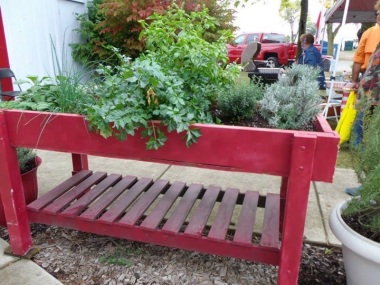Ohio AgrAbility is part of a national program dedicated to “cultivating accessible agriculture” by “helping injured or disabled famers.” Ohio AgrAbility and the OSU Extension Family and Consumer Sciences have partnered for many years at the Farm Science Review to show how Universal Design concepts from the home can also be used in the garage, shop, barn and garden. While farming is very different from gardening, the Ohio AgrAbility program generously shares relevant information and resources to make gardening easier and more accessible to all people. This article contains ideas of resources and information that can help may gardening and yard work easier for many of us.

One of many benefits of raised beds and container gardens is that they can be easier to use for individuals who have a hard time reaching to the ground. A raised bed might be designed with a wide edge to allow someone to sit while they work. Another type of raised gardening space is a garden table. The University of Maryland Extension shares instructions for building and growing a Salad Table.
 Ergonomic tools are designed to help people work and live better and to prevent injury. An example of an ergonomic tool is a heavy-duty work glove that has a wide strip of Velcro to attach the handle of the tool to fit inside the grip of the gloved hand. This is helpful to those who might not have a strong grip or full use of their hand. Interested in more details about tips and tools for making the garden more accessible? Read the factsheet, Gardening with a Physical Limitation.
Ergonomic tools are designed to help people work and live better and to prevent injury. An example of an ergonomic tool is a heavy-duty work glove that has a wide strip of Velcro to attach the handle of the tool to fit inside the grip of the gloved hand. This is helpful to those who might not have a strong grip or full use of their hand. Interested in more details about tips and tools for making the garden more accessible? Read the factsheet, Gardening with a Physical Limitation.
Safety is another important feature of Universal Design and can be addressed in many ways from bright enough lighting, handrails along steps and stairs and clear wide walkways. In the yard and garden, make sure the edges between lawns, garden beds and walkways are level and easy to see. Here is one basic example of making a minor change in the yard in order to increase the level of safety.

Notice the long, heavy hose? It moved with the owner to this new home from a much, much larger yard. It is laying in the walkway because that is the location of the water spigot. Humans are probably at more risk than the dog at tripping over this hose. One simple, quick solution was to design a place to “store” the hose when not in use. It could have been a hose reel or hose cart but the owner already owned a large, blue empty planter. Not pictured here is that the owner eventually purchased a shorter, light-weight expandable hose that was not only easier to store when not in use but also easier and safer to use around the yard to reach the garden beds.
 One description of the elements of universal design, “is a home that fits everyone’s needs, whether they are young or old, short or tall, with physical limitations or without”. In a similar way, gardens can be designed to meet the needs of all ages and physical differences to make it a safe and enjoyable hobby for all.
One description of the elements of universal design, “is a home that fits everyone’s needs, whether they are young or old, short or tall, with physical limitations or without”. In a similar way, gardens can be designed to meet the needs of all ages and physical differences to make it a safe and enjoyable hobby for all.
Written by: Patrice Powers-Barker, Extension Educator, Family and Consumer Sciences, Ohio State University Extension, Lucas County, powers-barker.1@osu.edu
Reviewed by: Lisa Barlage, Extension Educator, Family and Consumer Sciences, Ohio State University Extension, Ross County, barlage.7@osu.edu.
Sources:
Ohio AgrAbility, (2019) Ohio State University Extension https://agrability.osu.edu/universal-design/recommendations
Farm Science Review (2019), Ohio State University https://fsr.osu.edu/
Universal Design (2019) Family and Consumer Sciences, Ohio State University Extension https://fcs.osu.edu/programs/major-program-areas/healthy-relationships/universal-design
Salad Tables (2019), The University of Maryland Extension, https://extension.umd.edu/hgic/topics/salad-tables%E2%84%A2
Jepsen, D. (2013) Gardening with a Physical Limitation, Ohio State University Extension https://ohioline.osu.edu/factsheet/AEX-983.3

[…] gardening offers easy access to fresh, in-season produce for all ages and abilities. Ohio State University Extension […]